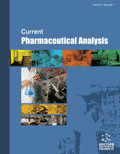
Current Pharmaceutical Analysis
Scope & Guideline
Advancing the Frontiers of Pharmaceutical Research
Introduction
Aims and Scopes
- Analytical Method Development and Validation:
The journal emphasizes the creation and validation of new analytical techniques, particularly in high-performance liquid chromatography (HPLC), mass spectrometry (MS), and other cutting-edge methods, ensuring accuracy and reliability in pharmaceutical analysis. - Pharmacokinetics and Drug Metabolism Studies:
Research on the pharmacokinetics of drugs, including absorption, distribution, metabolism, and excretion (ADME), is a core focus, providing insights into drug behavior in biological systems. - Quality Control and Assurance in Pharmaceuticals:
The journal addresses methodologies for quality control and assurance, including the evaluation of impurities, stability studies, and compliance with regulatory standards, critical for ensuring the safety and efficacy of pharmaceutical products. - Emerging Analytical Technologies:
The journal explores innovative analytical technologies such as electrochemical sensors, nanotechnology, and metabolomics, contributing to advancements in drug analysis and development. - Natural Products and Herbal Medicine Analysis:
There is a significant interest in the analytical study of natural products and herbal medicines, including their pharmacological effects and active constituents, highlighting traditional and alternative medicine efficacy. - Environmental and Food Safety Analysis:
The journal also covers analytical methods related to environmental monitoring and food safety, focusing on the detection of pharmaceutical contaminants and their impact on health.
Trending and Emerging
- Integration of Chemometrics in Analytical Methods:
There is a growing trend towards the integration of chemometric techniques with analytical methods, enhancing data interpretation and improving the robustness of results in complex pharmaceutical analyses. - Use of Nanotechnology in Drug Analysis:
Research exploring the application of nanotechnology, particularly in drug delivery and detection methods, is on the rise, highlighting its potential to revolutionize pharmaceutical analysis. - Focus on Biologics and Biosimilars:
An increasing number of studies are dedicated to the analysis of biologics and biosimilars, reflecting the industry's shift towards these complex molecules and the need for specialized analytical methods. - Sustainable and Green Analytical Chemistry:
Emerging themes include the development of eco-friendly analytical methods, emphasizing the importance of sustainability in pharmaceutical analysis and the reduction of hazardous waste. - Metabolomics and Pharmacometabolomics:
The application of metabolomics in understanding drug interactions and metabolic pathways is trending, indicating a shift towards personalized medicine and tailored therapeutic approaches. - Advanced Drug Formulation Techniques:
There is a noticeable increase in research focused on advanced drug formulation techniques, including nanocarriers and targeted delivery systems, which require innovative analytical methods for their characterization.
Declining or Waning
- Traditional Analytical Techniques:
There is a noticeable decline in the use of conventional analytical methods such as basic UV-Vis spectroscopy and colorimetry, as researchers increasingly favor more sophisticated techniques like LC-MS and HPLC. - General Reviews on Established Drugs:
The publication of general reviews focusing on well-established drugs has decreased, as the journal shifts towards more innovative and emerging therapeutic agents and their analytical challenges. - Chemical Reagent-Based Methods:
Methods relying heavily on chemical reagents for analysis are becoming less prominent, with a growing preference for greener, more sustainable analytical practices that minimize environmental impact. - In Vivo Studies with Limited Scope:
The frequency of in vivo studies that lack comprehensive analytical methodologies is declining, as the journal encourages more robust, methodologically sound research that includes detailed pharmacokinetic profiles.
Similar Journals

Clinical Pharmacology in Drug Development
Elevating drug development through peer-reviewed excellence.Clinical Pharmacology in Drug Development, published by WILEY, is a distinguished journal dedicated to advancing the field of pharmaceutical science and drug development. With a strong commitment to disseminating cutting-edge research, this journal serves as a crucial platform for professionals, researchers, and students aiming to enhance their understanding of pharmacological principles and innovations in medical therapeutics. Since its inception in 2012, the journal has consistently maintained a noteworthy presence in the academic community, currently achieving a Q2 ranking in both Pharmaceutical Science and Medical Pharmacology categories as of 2023. Although the journal operates under a subscription model, it is highly regarded for its rigorous peer-reviewed publications, offering insights into drug efficacy, safety, and regulatory challenges. Positioned at the intersection of clinical practices and pharmaceutical advancements, Clinical Pharmacology in Drug Development plays an essential role in bridging the gap between scientific research and real-world application, ensuring that the latest therapeutic strategies are optimized for patient care.

Turkish Journal of Pharmaceutical Sciences
Empowering Researchers in Pharmaceutical SciencesThe Turkish Journal of Pharmaceutical Sciences, an esteemed publication by GALENOS PUBL HOUSE, has been a prominent platform for research and innovation in the fields of Pharmaceutical Sciences and Molecular Medicine since its inception as an Open Access journal in 2004. Based in Turkey, this journal serves as a vital resource for researchers, professionals, and students keen on exploring the latest advancements in drug development, pharmacology, and therapeutic innovations. With an ISSN of 1304-530X and an E-ISSN of 2148-6247, the journal is indexed in leading databases and has demonstrated strong rankings in the Scopus index, notably securing the second quartile in Pharmaceutical Sciences. Furthermore, it fosters academic collaboration and knowledge dissemination by making its content freely accessible. The journal aims to inspire groundbreaking research, providing an important academic forum for the dissemination of valuable insights that impact the pharmaceutical sector and contribute to global health.
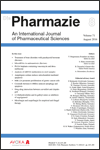
PHARMAZIE
Bridging research and practice in pharmacology.PHARMAZIE is a prestigious, peer-reviewed journal published by AVOXA-MEDIENGRUPPE DEUTSCHER APOTHEKER GMBH, focusing on the dynamic field of pharmaceutical science since its inception in 1947. With its ISSN 0031-7144 and a current impact factor placing it in the Q2 category of Pharmaceutical Science journals, PHARMAZIE has established itself as a pivotal resource for researchers, practitioners, and students alike. The journal emphasizes the dissemination of high-quality, original research in pharmacology, toxicology, and pharmaceutics, contributing to the advancement of knowledge and innovation in these fields. While currently not open access, the journal maintains a commendable Scopus rank of #94 out of 183 in its category, highlighting its relevance and appeal to the academic community. With a commitment to bridging the gap between research and practical applications, PHARMAZIE plays a crucial role in shaping the future of pharmaceutical practices and policies.
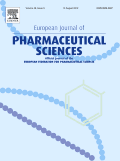
EUROPEAN JOURNAL OF PHARMACEUTICAL SCIENCES
Fostering Insights that Shape the Future of MedicineThe European Journal of Pharmaceutical Sciences is a prestigious academic journal dedicated to advancing the field of pharmaceutical science. Published by Elsevier, the journal boasts an impressive impact factor and is categorized in the Q1 quartile for pharmaceutical science as of 2023, signifying its influence and reputation within the academic community. With a Scopus ranking of #20 out of 183 in the fields of pharmacology, toxicology, and pharmaceutics, the journal provides a vital platform for researchers and practitioners to disseminate innovative studies and groundbreaking research that push the boundaries of drug development and delivery. Based in the Netherlands and operating since 1993, the journal seeks to cover a broad scope of topics related to pharmaceutical sciences, encouraging rigorous evaluations and discussions that enhance the understanding and application of this critical field. The absence of open access underscores the commitment to maintaining high scholarly standards, while still offering avenues for libraries and institutions to provide access to cutting-edge research. As the journal converges towards its 2024 milestones, it continuously aims to foster a vibrant exchange of knowledge among its diverse readership, comprising committed researchers, professionals, and students.
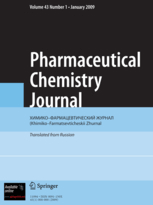
PHARMACEUTICAL CHEMISTRY JOURNAL
Empowering Researchers in Pharmaceutical Sciences.Pharmaceutical Chemistry Journal is a pivotal publication in the field of pharmaceutical sciences, renowned for its in-depth articles and research findings. Published by Springer in the United States, this journal provides a crucial platform for researchers, students, and professionals dedicated to advancing drug discovery and pharmacology. With an ISSN of 0091-150X and an E-ISSN of 1573-9031, this journal has consistently aimed to promote scholarly communication and innovation within its scope since its inception in 1967. Despite its current Category Quartiles ranking of Q4 in both Drug Discovery and Pharmacology, the journal remains a valuable resource for disseminating new ideas and findings that contribute to the scientific community. Researchers benefit from the journal's commitment to high-quality peer-reviewed content, even in an environment where open access options are currently not available. As the field evolves, the Pharmaceutical Chemistry Journal continues to play an important role in shaping future advancements in drug development and safety.

JOURNAL OF FOOD AND DRUG ANALYSIS
Connecting Science to Society through Food and Drug ResearchJOURNAL OF FOOD AND DRUG ANALYSIS, an esteemed publication in the realms of Food Science and Pharmacology, is published by DIGITAL COMMONS BEPRESS. With an impactful commitment to open access since 2013, this journal facilitates the dissemination of critical research findings, making them readily available to a global audience. Boasting a commendable Q2 ranking in both Food Science and Pharmacology, the journal occupies a prominent position in its respective categories, reflecting its quality and relevance in the field. Established in 1994, the journal has successfully converged its focus to encompass a wide range of topics related to the analysis of food and drugs, thereby providing valuable insights to researchers, practitioners, and students alike. With its indexed indicators in Scopus showcasing a strong performance—ranking #85 among 389 in Food Science and #108 among 313 in Pharmacology—it stands as a crucial platform for the advancement of knowledge and innovation. For those looking to stay abreast of pivotal developments in food safety and drug efficacy, JOURNAL OF FOOD AND DRUG ANALYSIS is an indispensable resource.

Analytical and Bioanalytical Chemistry Research
Enhancing Understanding through Open Access Chemistry.Analytical and Bioanalytical Chemistry Research is an esteemed open-access journal published by the Iranian Chemical Society, dedicated to the advancement of knowledge in the fields of analytical chemistry, biochemistry, and spectroscopy. Since its inception in 2014, this journal has provided a platform for researchers, professionals, and students to publish and access high-quality research articles that contribute to the understanding of chemical analysis and bioanalytical methods. With an ISSN of 2383-093X and an open-access model that promotes global dissemination of findings, it ensures that innovative research reaches a broad audience. The journal has consolidated its presence in the scientific community, currently ranked in quartile Q4 for analytical chemistry, biochemistry, and spectroscopy as of 2023. Its Scopus rankings, including a percentile of 34th in Analytical Chemistry, reflect its commitment to quality research and scholarly contribution. Situated in Tehran, Iran, the journal serves as a vital resource for academic discourse, offering insights into emerging trends and methodologies in analytical and bioanalytical chemistry.

ACTA PHARMACEUTICA
Your gateway to groundbreaking research in medicine and pharmaceuticals.ACTA PHARMACEUTICA is a distinguished open-access journal published by SCIENDO, dedicated to advancing knowledge in the fields of medicine and pharmaceutical sciences. Established in 1992, the journal has made significant contributions to the scholarly community, providing a platform for innovative research and discussion. With a strong presence in both Q2 and Q3 quartiles across various categories including Pharmaceutical Science and Pharmacology, ACTA PHARMACEUTICA ranks favorably, positioning its contributions in the upper tiers of the field. The journal's commitment to open access since 2007 ensures that both practitioners and scholars have immediate access to cutting-edge developments, thereby fostering collaboration and knowledge sharing. With its scope spanning a broad spectrum of pharmaceutical and biomedical research, ACTA PHARMACEUTICA is an essential resource for researchers, professionals, and students keen to stay abreast of the latest advancements and trends in these vital areas of study.

Istanbul Journal of Pharmacy
Exploring new frontiers in drug formulation and delivery.Istanbul Journal of Pharmacy, published by Istanbul University, Faculty of Pharmacy, is a pivotal platform dedicated to the advancement of pharmaceutical sciences and technology. This journal serves as a vital resource for researchers, professionals, and students alike, seeking to disseminate cutting-edge research, reviews, and innovative methodologies within the pharmaceutical discipline. With a commitment to open access, the journal aims to foster a collaborative environment that promotes information sharing and scholarly discourse. The Istanbul Journal of Pharmacy invites submissions that delve into diverse topics ranging from drug formulation to pharmacokinetics, ensuring that readers are equipped with the latest insights and discoveries in the field. This journal is positioned to enhance scientific communication within the pharmaceutical community and support the continuous evolution of pharmacy practice and education globally.
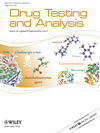
Drug Testing and Analysis
Exploring the Frontiers of Analytical ChemistryDrug Testing and Analysis is a leading scholarly journal published by WILEY, dedicated to advancing the field of drug testing and analytical methods. With ISSN 1942-7603 and E-ISSN 1942-7611, this journal provides a platform for the latest research in Analytical Chemistry, Pharmaceutical Science, and Environmental Chemistry, holding a prestigious reputation reflected in its Q1 and Q2 rankings across various categories in 2023. The journal promotes high-impact studies that explore innovative methodologies, with a specific focus on pharmacological and toxicological analyses, making it an essential resource for researchers, professionals, and students concerned with drug efficacy, safety, and environmental impact. With a strong commitment to quality and relevance, Drug Testing and Analysis remains at the forefront of contemporary scientific inquiry, contributing significantly to both academic and practical advancements in the industry.